Tskaltubo and its abandoned sanatoriums drew me in with their haunting beauty and forgotten history. Once the most glamorous spa resort in Soviet Georgia, this quiet town was famous for its radon-rich thermal waters and palatial retreats where workers and Soviet elites came to heal and relax. Today, the old sanatoriums stand in eerie silence, with their vast empty halls frozen in time. (Or sometimes occupied by refugees, but this is another story to tell). If you’re into history, photography, or you’re just a curious urban explorer, I’m pretty sure you’ll appreciate the melancholic beauty of Soviet decay in Tskaltubo.
Table of Contents
Tskaltubo: A Must-Visit Destination for Your Georgia Trip
Today, Tskaltubo is a sleepy, laid-back town where everyday life moves at a gentle pace. Locals gather in small cafés and bakeries, enjoying fresh khachapuri and strong Georgian coffee. A few renovated spas and hotels hint at a new life for the city, attracting visitors seeking both history and relaxation.
PLAN YOUR TRIP TO GEORGIA
Stay online everywhere in Georgia with Holafly eSIM and enjoy unlimited data, fast internet, no roaming: perfect for using Google Maps and sharing your trip as you go.
Travel worry-free with Heymondo travel insurance, so you can enjoy every moment of your Georgian adventure without stress.
But for most travellers like me, the real magic of Tskaltubo lies in its abandoned sanatoriums. They’re hauntingly beautiful, with grand buildings slowly swallowed by nature, crumbling Soviet mosaics, and silent thermal baths that once hosted thousands of guests.
Walking through these forgotten corridors makes you feel like a true urban explorer, discovering secrets frozen in time. But it also leaves you wondering how a place that was once so glamorous and lively ended up like this.
From a Glamorous Soviet Spa to a Forgotten Town
Tskaltubo rose to fame in the 1920s, when the newly formed Soviet Union sought to establish health resorts where workers could recover from years of labour and experience the benefits of the socialist system. The town was carefully planned around naturally warm radon-carbonate springs that bubbled up from the surrounding limestone hills.
For Soviet citizens, a stay in Tskaltubo was more than just a holiday. It was a state-sponsored reward for loyalty and service. Workers were often given vouchers for one or two weeks of rest, complete with medical supervision, spa treatments, and cultural activities.
Over time, Tskaltubo became a highly privileged retreat, home to 19 grand sanatoriums operated by different trade unions. Each had its own architectural style, from neoclassical elegance to Soviet modernism, but all were monumental and designed to impress.
Guests could enjoy luxurious thermal baths, attend lectures on health and ideology, watch performances in theatres, and take part in evening dances.
By the 1980s, Tskaltubo had grown into one of the most popular spa resorts in the entire Soviet Union. It was also attracting visitors from other socialist countries, such as East Germany and Czechoslovakia. Even Joseph Stalin had a private dacha nearby, further elevating Tskaltubo’s prestige.
Tskaltubo’s Healing Waters and Soviet-Era Fame
What made Tskaltubo truly special were its unique radon-carbonate mineral waters, naturally warm at 33°C and believed to have powerful healing properties. Soviet doctors prescribed them for a wide range of conditions, from cardiovascular diseases and rheumatism to metabolic disorders, skin problems, and even infertility.
These health benefits were taken very seriously, and Tskaltubo became part of the state-run healthcare system. Guests received comprehensive medical check-ups, personalised treatment plans, and were closely monitored by doctors throughout their stay.
By the mid-20th century, Tskaltubo hosted over 100,000 visitors each year. Direct overnight trains connected the town with Moscow, Leningrad, and other major Soviet cities, making it easy for people from across the USSR to visit.
What made Tskaltubo different from Western spa towns was its egalitarian approach: ordinary factory workers could share the same facilities as decorated war veterans, party officials, and even foreign dignitaries.
The sanatoriums weren’t just places to heal. Sanatoriums were a showcase of socialist ideals, a symbol of how the State cared for its people.
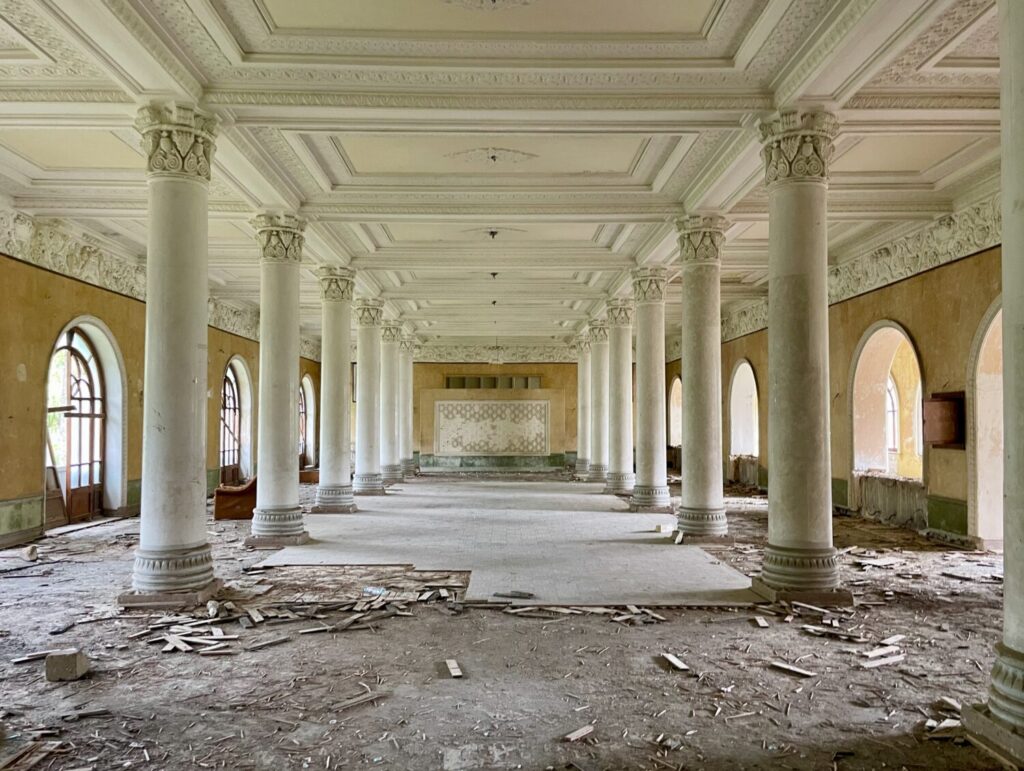
The Decline of Tskaltubo After the Fall of the USSR
The collapse of the USSR in 1991 brought Tskaltubo’s golden age to an abrupt end. Overnight, the state funding that maintained the sanatoriums disappeared. Trains from Moscow stopped running, and the thousands of workers who once came on subsidised vouchers simply vanished.
Without the support of the Soviet system, the spa town’s carefully managed infrastructure began to fall into disrepair. After Georgia’s independence, by the mid-1990s, many of Tskaltubo’s grand buildings were completely abandoned.
Refugees Living Inside the Abandoned Sanatoriums
The abandoned sanatoriums found an unexpected new purpose in the early 1990s. During the war in Abkhazia, around 9,000 refugees fled the conflict and were relocated to the empty buildings of Tskaltubo.
More than thirty years later, some of these families are still living in parts of the sanatoriums. Over time, they have adapted the buildings to their needs, turning former spa facilities into makeshift homes.
With the growing interest from tourists, some refugees have also started to make a small income from the curiosity around these ruins. For example, at the Sanatorium Metallurgist, you might find unfriendly residents at the entrance asking for 5 GEL just to step into the lobby.
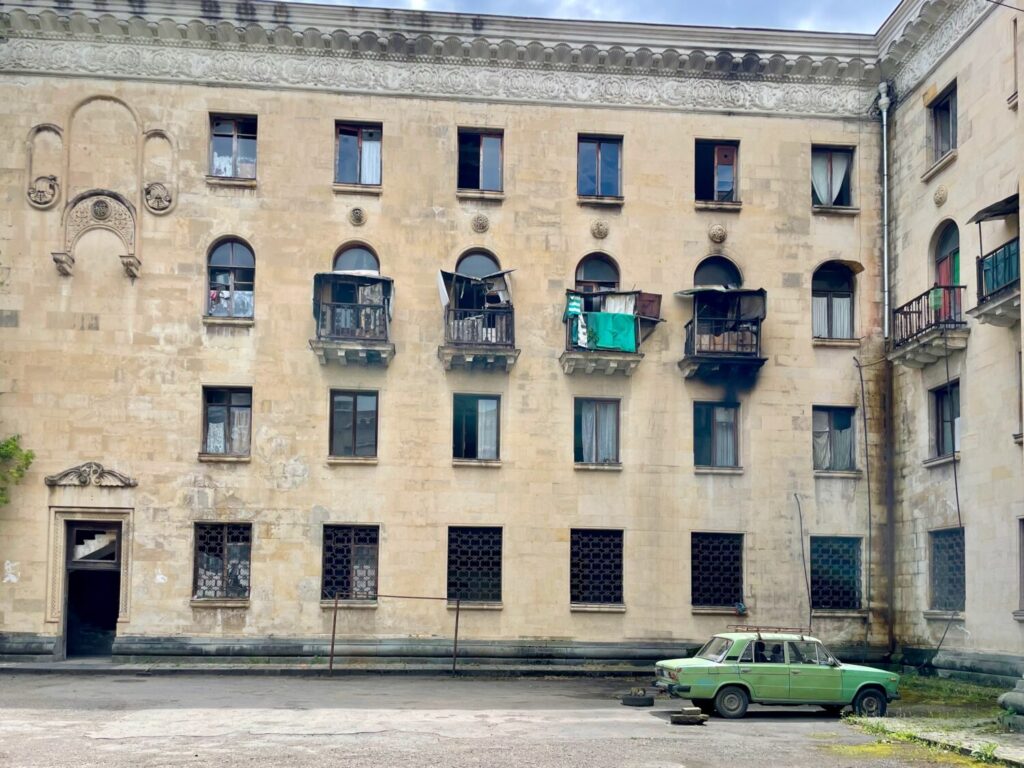
Urban Exploration in Tskaltubo: Discovering Georgia’s Abandoned Sanatoriums
Decades after its decline, Tskaltubo was rediscovered by urban explorers, photographers, and curious travellers drawn to its haunting Soviet-era ruins. Word spread about the town’s eerie beauty: grand staircases overgrown with ivy, crumbling mosaics, and silent thermal baths frozen in time.
I chose to explore these abandoned sanatoriums out of pure curiosity. There’s something fascinating about stepping into a place where history lingers in every corner, imagining the lives of the guests who once filled these halls and seeing how nature has slowly reclaimed what was once a proud showcase of Soviet health tourism.
Enterprising locals now offer informal tours, guiding visitors through the most striking buildings and sharing stories of their past. This is the case of my visit to the Imereti Sanatorium, where the guards at the entrance were perfectly organised to offer interesting tours between the past and the present.
Although there have been occasional plans for redevelopment, most sanatoriums remain untouched, making Tskaltubo a true magnet for anyone fascinated by abandoned architecture, forgotten history, and the thrill of urban exploration.
However, urban exploration here is exciting but also requires some planning. Before you set off, it’s important to know what to expect, including whether it’s safe to enter these old buildings and what you will actually find inside.
How to Safely Explore Tskaltubo’s Abandoned Sanatoriums
The sanatoriums may appear solid from the outside, but many are structurally unstable on the inside. You’ll find broken floors, cracked staircases, loose ceilings, and exposed wiring.
Always wear sturdy shoes with good grip, but it’s best to explore with someone else who knows the place for safety. They can also share stories and details you might otherwise miss. (Although not always historically accurate!).
Is It Legal to Enter the Ruins? What You Need to Know
The legal situation in Tskaltubo is a bit of a grey area. Most sanatoriums are officially abandoned, but some are privately owned or earmarked for redevelopment, which means access can change at any time. To avoid problems, it’s always a good idea to visit with a guide or a local contact who knows which places are open and which are off-limits.
In some cases, locals may charge a small fee for access. This can include guards at the entrances of privately owned buildings or refugees in those that are still occupied.
A few sanatoriums are, in fact, still partially inhabited by refugee families, so you should always ask for permission before entering. They’re not always friendly, like at the Sanatorium Metallurgist, where it was taken for granted that people had to pay a fee just to see the chandelier in the lobby, the only accessible part of the building that hadn’t been turned into illegal housing.
The experience was very different at the Imereti Sanatorium, where the guards were much friendlier and even eager to share stories about Soviet Georgia and the ruined building itself.
However, it’s clear just how grey the situation really is when the same guards, acting as impromptu tour guides, kindly ask you not to post photos with them online. And of course, the pictures with our very friendly guard-tour guide remain private on my computer.
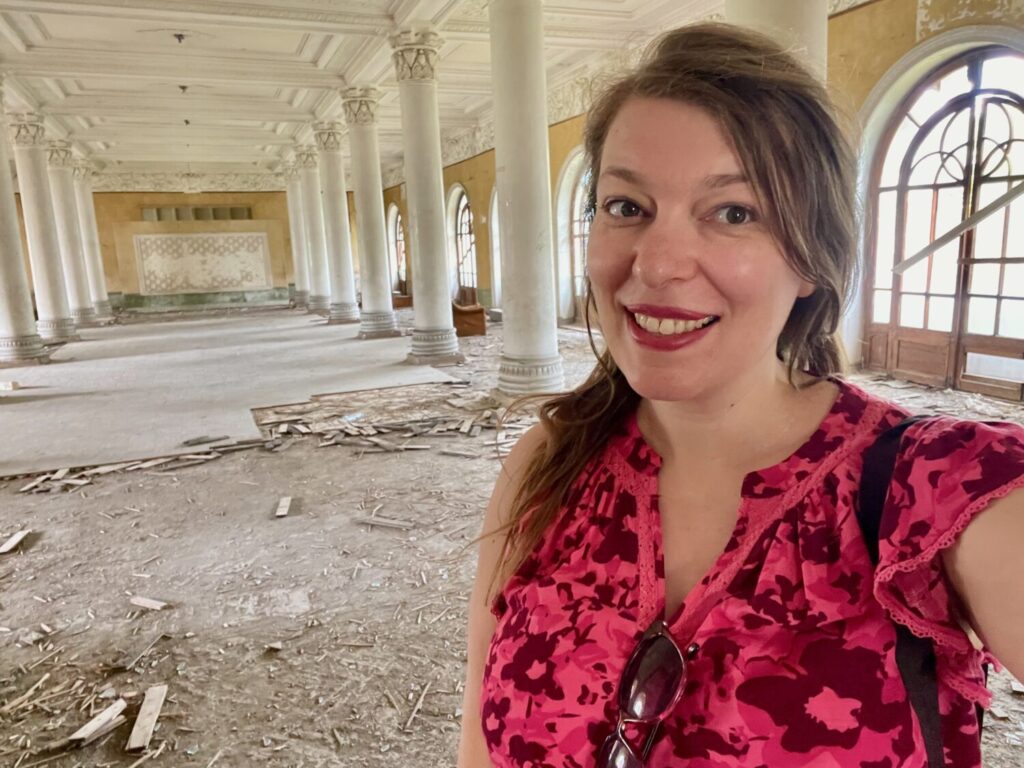
What You’ll See Inside the Abandoned Sanatoriums
Stepping inside these sanatoriums is an unforgettable experience. You’ll be greeted by vast neoclassical halls with marble columns, grand staircases overtaken by ivy, and intricate mosaics celebrating Soviet ideals.
The beauty of decay is everywhere: peeling paint, shattered windows, and long corridors leading to empty rooms that once hosted thousands of guests.
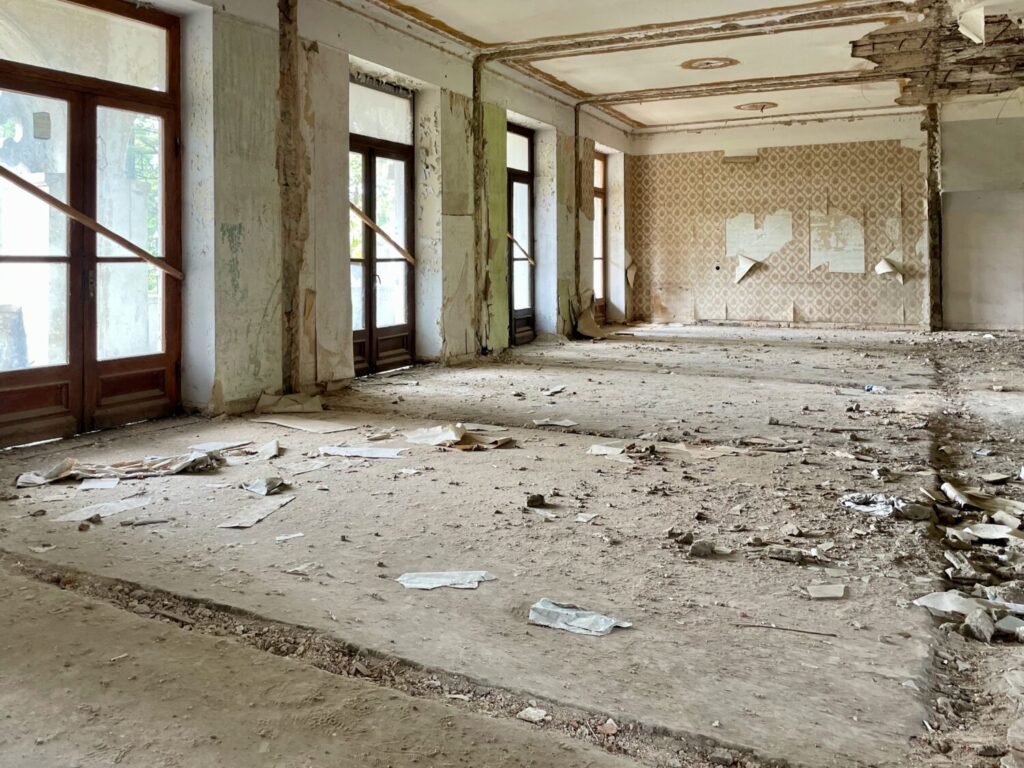
Apparently, some sanatoriums still hold traces of their past, such as rusted medical equipment, faded propaganda posters, and forgotten personal belongings left behind when guests never returned, but I didn’t find any.
In other places, nature has taken over completely, with trees growing through roofs and vines creeping along walls. It’s haunting, peaceful, and strangely beautiful all at once. Walking through these spaces, you truly feel like a true urban explorer uncovering the last remnants of a world that no longer exists.
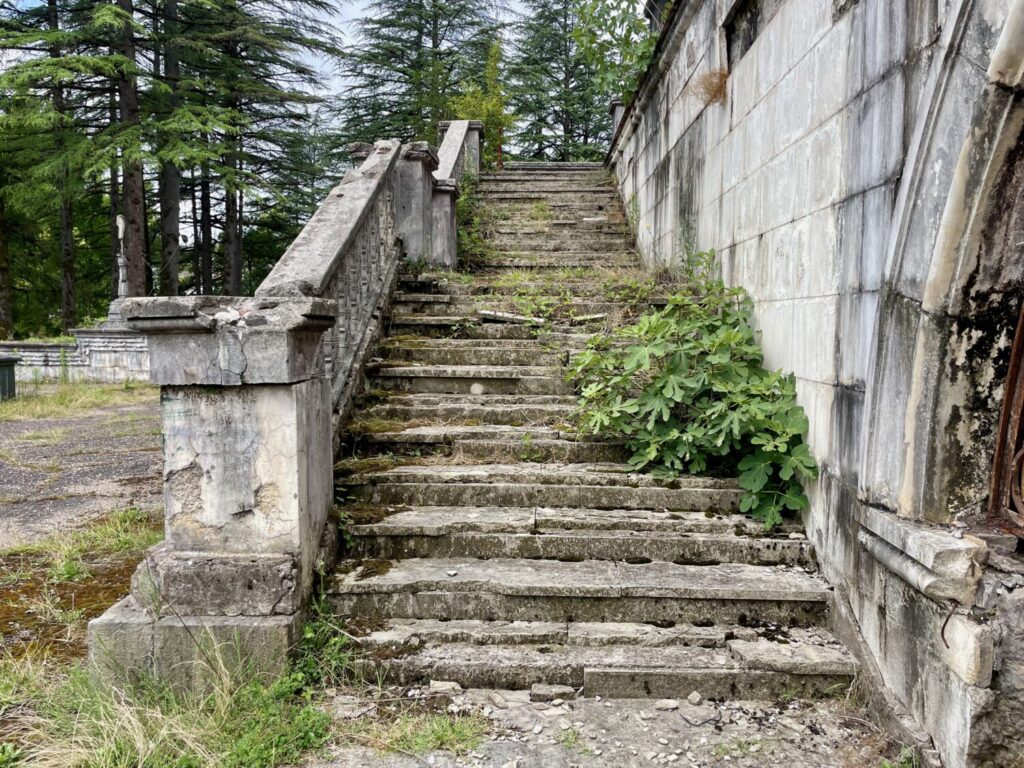
The Best Sanatoriums in Tskaltubo You Can’t Miss
There are many abandoned sanatoriums scattered across Tskaltubo, but you probably want to see just the most beautiful and interesting ones. Some are open and easily accessible, while others can only be admired from the outside.
During my half-day visit, I managed to explore inside Sanatorium Imereti and Sanatorium Metallurgist, but there are plenty more worth adding to your list. The Australian-Georgian blogger Emily Lush wrote the most extensive list of Tskaltubo’s sanatoriums on her blog Wander-Lush.
Many more sanatoriums can be easily found by searching Google Maps, allowing you to plan your own itinerary based on the time you have available. If you’re unsure whether a building is accessible, or if it might still be inhabited, it’s better not to wander in. The experience can quickly become unpleasant if you accidentally intrude where you’re not welcome.
Even though the sanatoriums aren’t far from each other as the crow flies, some are located on hills, making it impractical to visit them all on foot. Renting a car is definitely the easiest way to explore.
Alternatively, you can book a guided tour, such as the Kutaisi: Tskaltubo Abandoned Soviet-Era Spas Tour, which is perfect if you prefer the safety of a local guide who knows where you can and cannot go.
One fun little curiosity: “sanatorium” and “hotel” were used interchangeably during Soviet times. Generally, sanatoriums were much bigger, grander complexes intended for extended stays, while hotels were smaller and more modest!
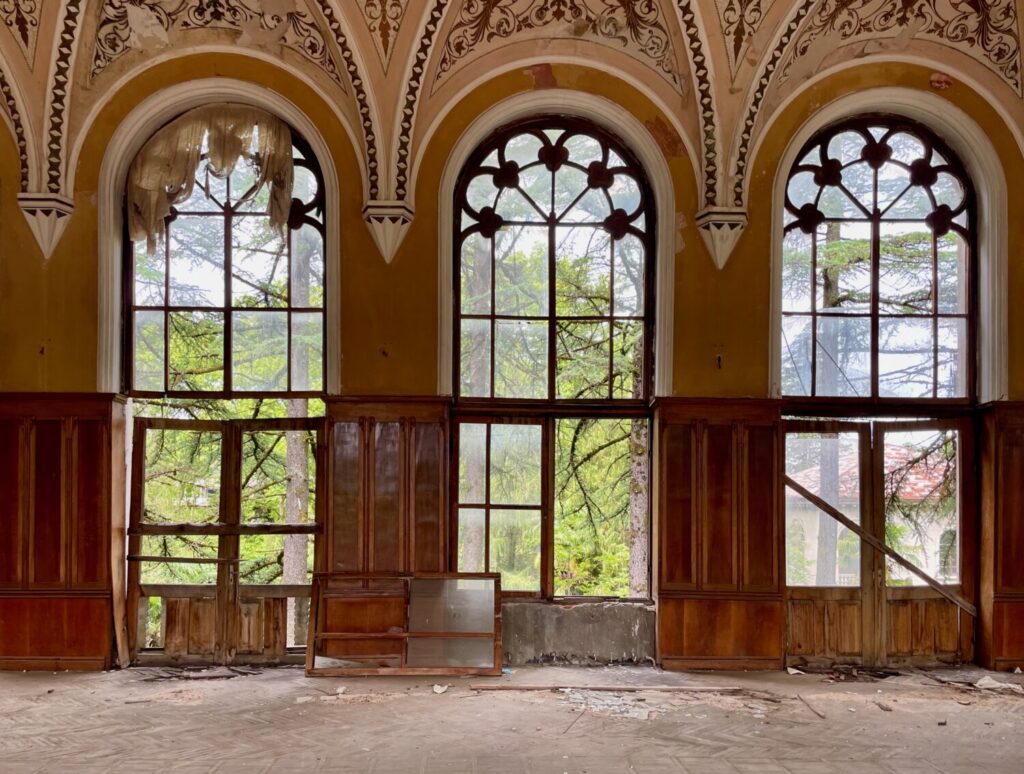
Sanatorium Imereti: A Grand Soviet Spa Frozen in Time
Built between 1950 and 1961 with 450 beds, Sanatorium Imereti is one of the most beautiful sanatoriums in Tskaltubo. This sanatorium has been purchased by investors, but it’s now back on the market due to the huge renovation costs.
Inside, Sanatorium Imereti has a stunning double staircase cast in black stone, marble columns, and sweeping halls that still showcase its former grandeur. Even in decay, you can feel the atmosphere of an era when Soviet citizens could enjoy a rare taste of luxury.
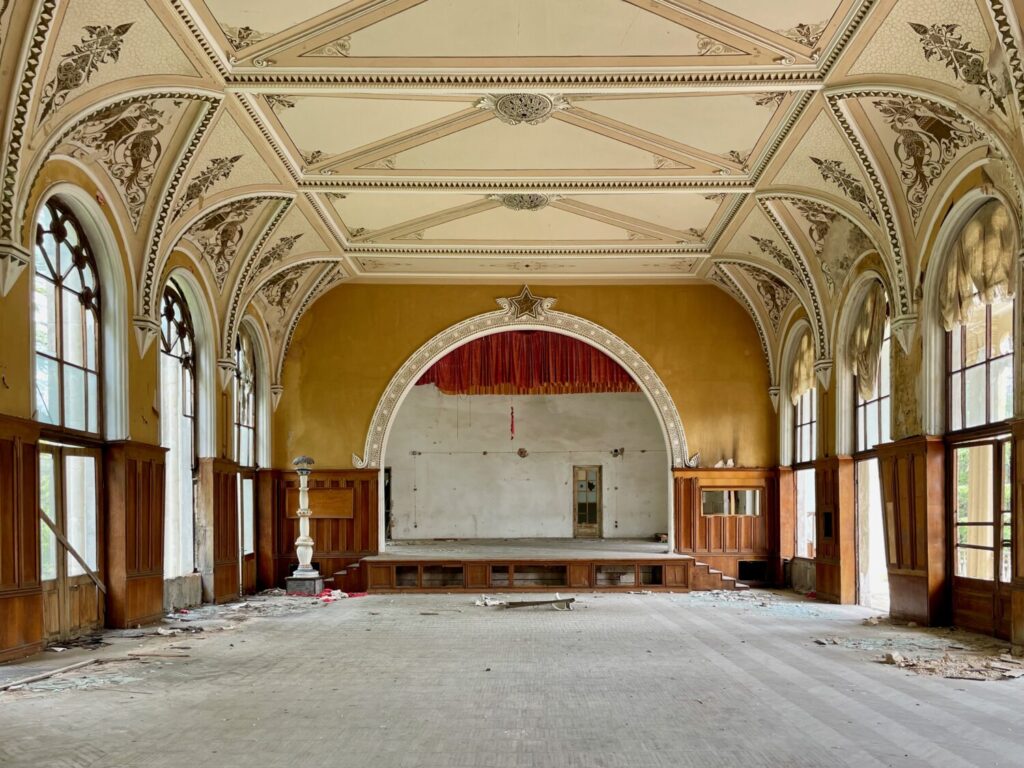
Imereti was a vacation sanatorium during the Soviet era when people from all 15 republics could stay here for free. In front of the building, there’s a small park with mineral water springs that were believed to heal kidney and bone problems. Visitors would also come here for treatments before resting in the sanatorium at night.
The Tour with the Guard: Hidden Stories and Exclusive Access
At the entrance, a gate prevents access. Still, for a fee of 20 GEL per person, approximately €6, the guards offer an “official” guided tour. It’s worth it: my guard-guide shares many fascinating stories, some of which may not always correct be accurate.
For example, he mentioned that the building was entirely constructed by German prisoners of war. However, this contradicts the information I found online, leaving me uncertain about the truth.
On the other hand, the visit was tinged with interesting revelations, such as the fact that for the Georgians the legend of the Argonauts was badly rewritten and completely ruined by the Greeks who should not have killed Queen Medea, a sort of goddess of medicine.
Despite part of the building being too unsafe to access due to collapsed floors, thanks to my “guide”, the tour was one of the highlights of my trip.
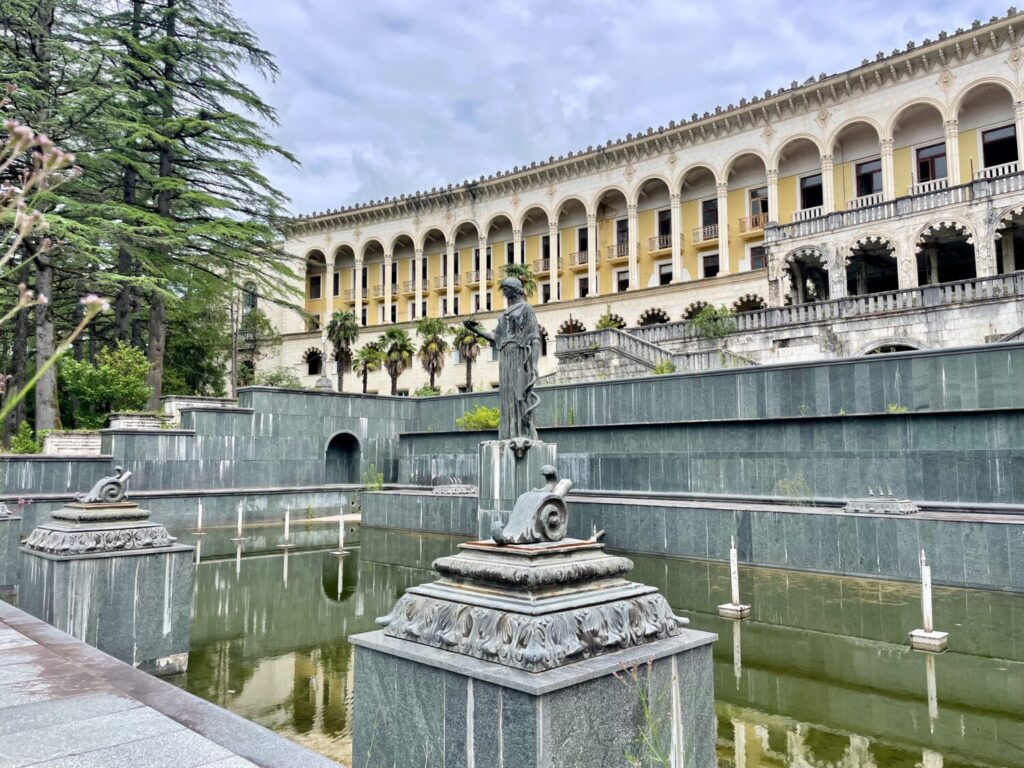
Sanatorium Metallurgist: The Famous Chandelier and Hidden Stories
The Metallurgist is one of the grandest sanatoriums in Tskaltubo, famous for its enormous chandelier. It should be the largest and best-preserved in any abandoned Soviet building. Vast halls, elegant columns, and impressive staircases should make it a photographer’s dream.
Unfortunately, the Metallurgist is currently occupied by refugees, and they’re not particularly welcoming. At the entrance, they charge 5 GEL, approximately € 1.50, just to access the lobby and see the chandelier, which is the only part of the building that has not been converted into housing. Beyond that, the rest of the building is off-limits because it is divided into apartments.
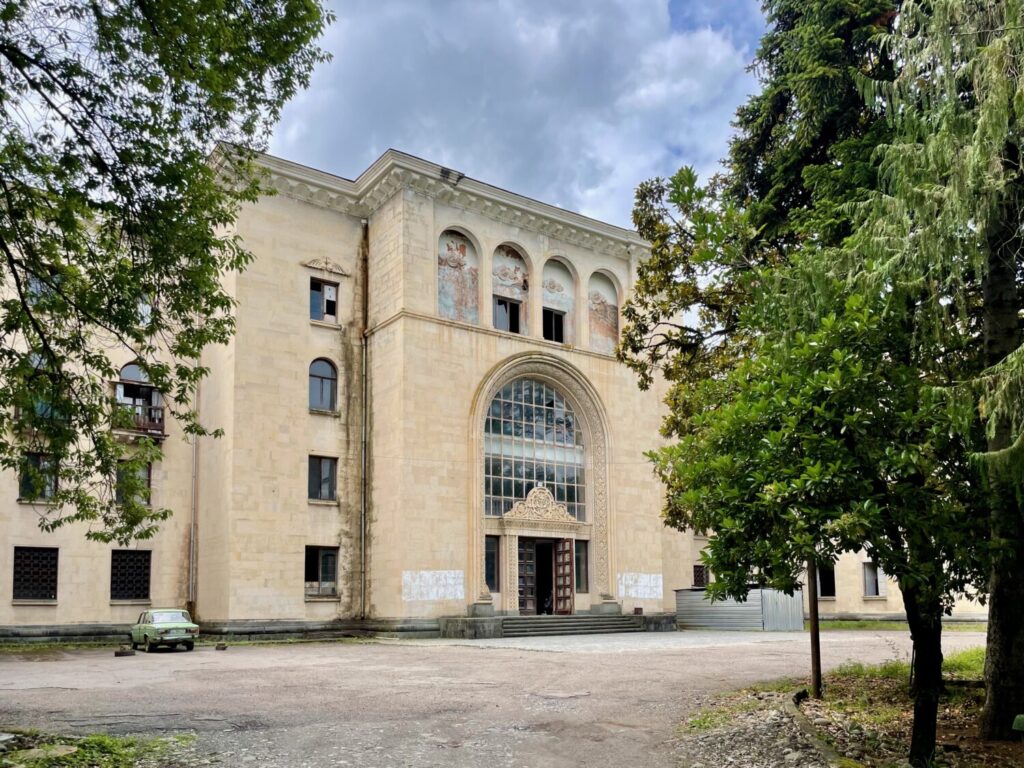
Of course, it was quite illegal, as it was the tour at the Sanatorium Imereti. This time, however, it has looked more like a forced bribe, without a guided tour or any benefits for visitors. The amount requested was very small, but I didn’t feel comfortable given the unfriendly welcome I received. So, I left almost immediately.
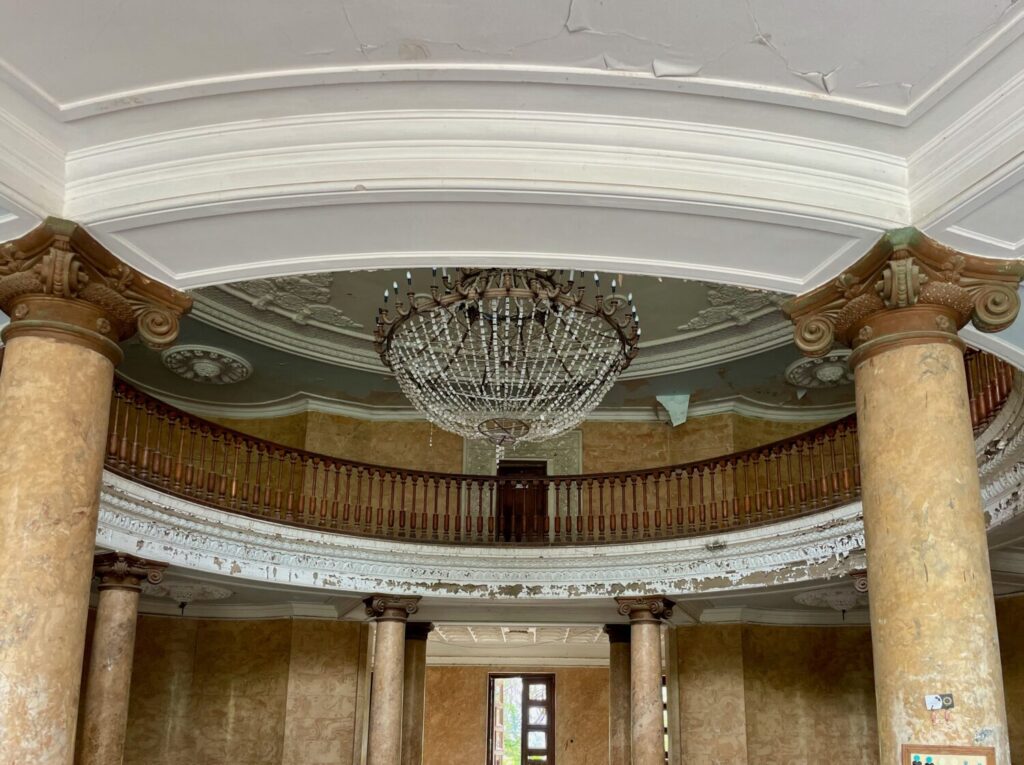
Sanatorium Medea: Neoclassical Beauty in Ruins
Built between 1954 and 1962, Sanatorium Medea was one of the most iconic structures in the resort. Its dramatic neoclassical facade with tall columns and arches is absolutely spectacular, making it a popular spot for wedding photos.
Originally named Sanatorium Tsekavshiri, it was later renamed after Medea from the myth of Jason and the Argonauts. It had 326 beds and was considered one of the largest complexes.
Today, Sanatorium Medea is completely empty and freely accessible. You can wander through the entire building, including the back areas that were once occupied by residents. I didn’t go inside, but I read online that rooms are still filled with abandoned furniture, clothes, toys, and even family photos.
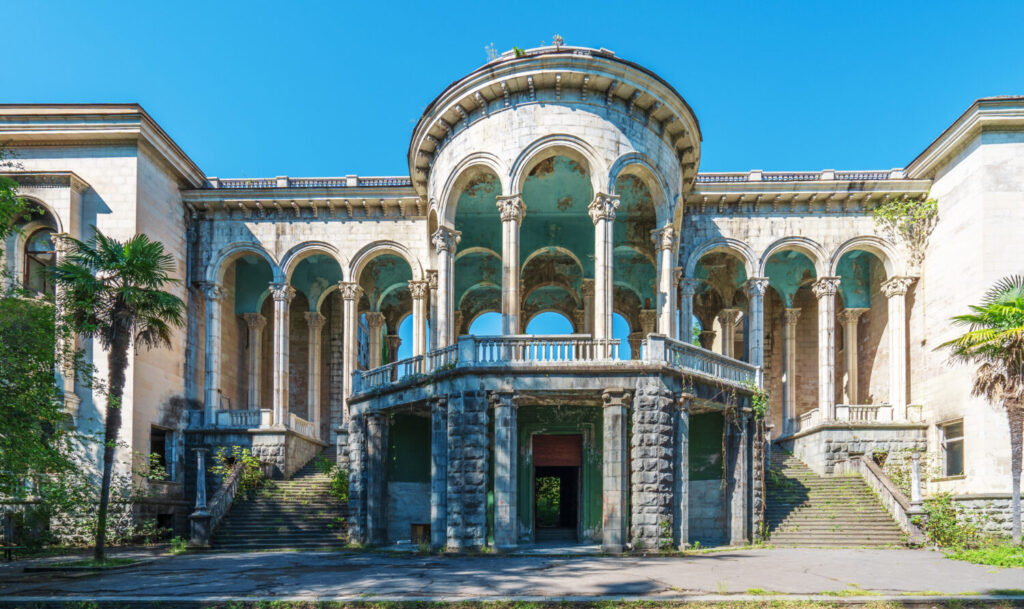
Sanatorium Iveria: Iconic Blue Walls and Faded Elegance
Built in 1962, Iveria was one of the best-known sanatoriums in Tskaltubo. Its entrance hall, with blue walls and a circular ceiling opening revealing the mezzanine, is instantly recognisable.
Completely abandoned, Iveria allows you to freely roam the top level. There, you’ll find tiled treatment rooms, a theatre, and even some street art. The bottom floor is mostly gutted, stripped of its original features.
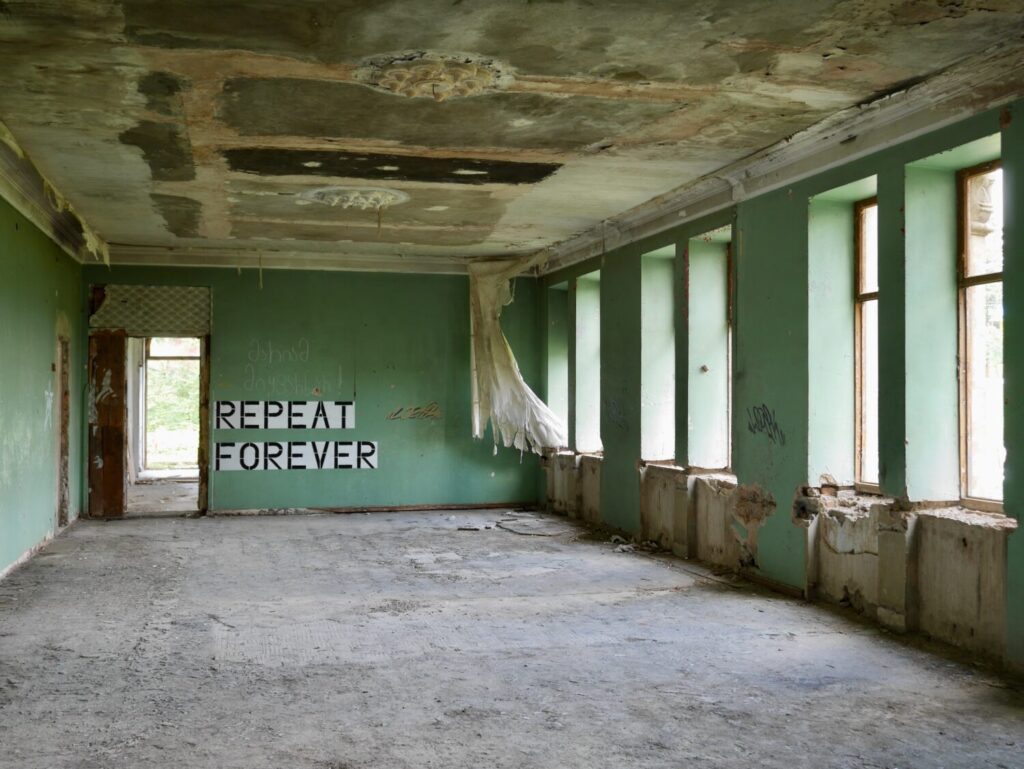
Iveria was sold to investors in 2017 and is slated for demolition and redevelopment. While it used to be easy to enter through an open gate, it’s now fenced off again. The problem with writing reliable information is that ownership and management often change, so you may not always find the Sanatorium Iveria open.
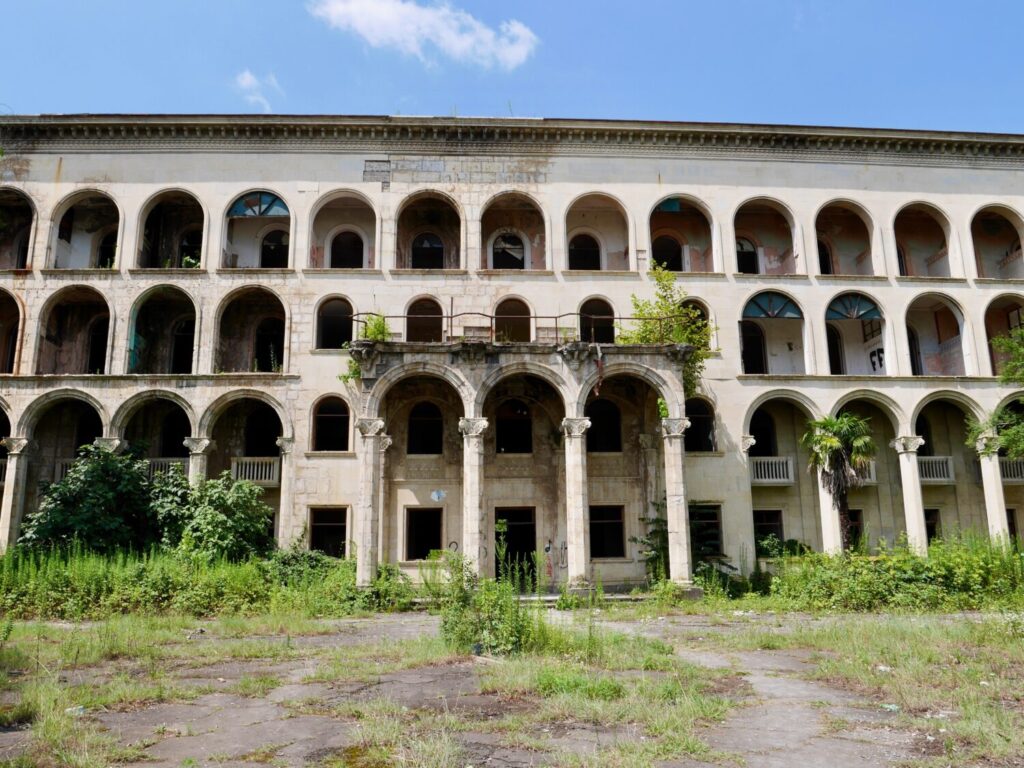
Sanatorium Gelati: Mosaics and the Playground of Soviet Childhood
Completed in 1964, Gelati is named after the nearby famous UNESCO monastery. The building features a more ornate design, complete with a Soviet-style belvedere above the roofline.
Currently, the sanatorium is occupied by refugees who have converted the space into apartments. In some cases, residents have even enclosed old balconies with bricks, creating small, improvised kitchens.
At the back of the building is the highlight: an impressive mosaic children’s playground, with curved walls and colourful animals such as deer, giraffes, and gryphons. Gelati, in fact, was the only sanatorium specifically dedicated to mothers and children.
Tskaltubo Spa Resort: A Former Military Sanatorium Reborn as a Hotel
Formerly used by the Soviet Ministry of Defence, this is the only sanatorium that’s been partially restored. It reopened in 2011 as the Tskaltubo Spa Resort, a 4-star hotel with 135 rooms.
Half of the massive 1947-built complex has been beautifully renovated, while the other half was left untouched. For this reason, staying here gives you a rare side-by-side comparison of decay and restoration.
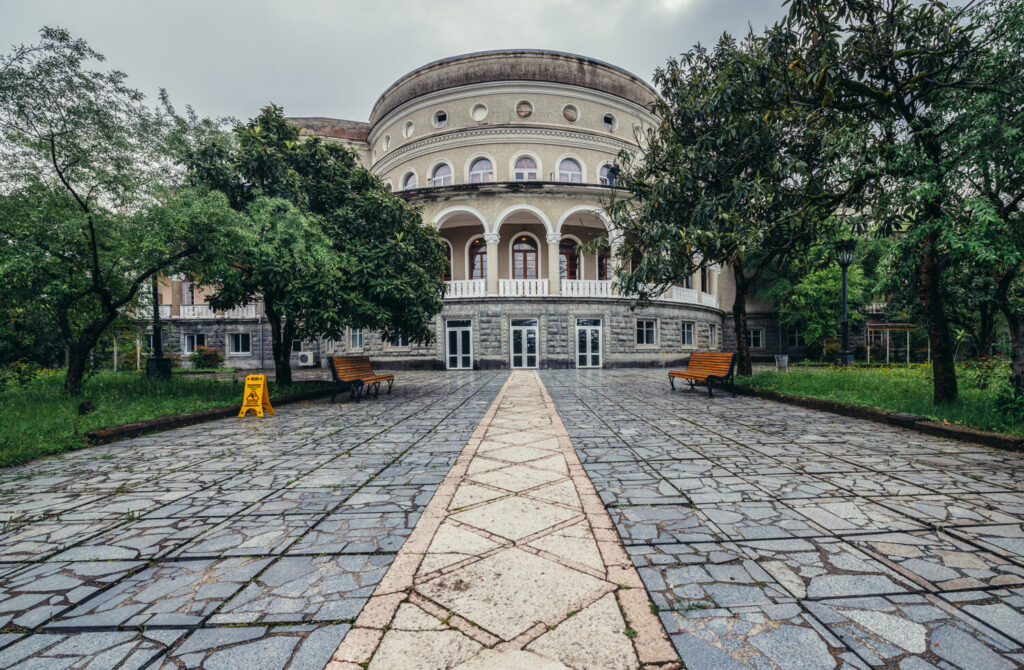
Other Fascinating Soviet Landmarks in Tskaltubo
Beyond the famous sanatoriums, Tskaltubo still holds a number of forgotten Soviet-era landmarks. From an abandoned railway station to a neglected post office and even Stalin’s elusive summer retreat, these places add extra layers of intrigue to your visit. Some are easy to find, others are shrouded in mystery or guarded, making them harder to explore.
Stalin’s Secret Dacha and the Former KGB Buildings
Stalin visited Tskaltubo only a handful of times. However, like everywhere else he favoured, he made sure to build a summer house here. Known as Stalin’s Dacha, it sits on a hill above the town. Of course, it’s also surrounded by myths about his visits and the secretive KGB presence that once guarded it.
Scattered around Tskaltubo are also dachas and private quarters that once hosted Stalin and other high-ranking Soviet officials. You can find their approximate locations on Google Maps, but many remain off-limits or difficult to access.
Unfortunately, I didn’t have the opportunity to explore these elusive landmarks myself. If you manage to visit them, please let me know so I can update this article.
Tskaltubo Railway Station: The Forgotten Gateway to the Spa Town
When vacationers arrived in Tskaltubo by train from Moscow, the railway station was their first impression of the spa town. Built in 1955, the cream-coloured stone building was suitably grand and elegant.
Today, it feels more like a set from a post-apocalyptic film. The train platforms are deserted and completely overgrown, while the tracks lead nowhere. All the windows are smashed, and the upper level is now completely empty.
The station was repaired in 2016 and briefly reopened as a tourist information office. However, since the office relocated, it has once again fallen into disrepair.
Tskaltubo Post Office: Modernist Ruins and Stained Glass Secrets
Tskaltubo’s abandoned post office has a striking modernist design. Built in the 1970s, also housed the city’s long-distance telephone service. The modern facade was added in the early 2000s, but the building was abandoned in 2013 and has been slowly deteriorating ever since. Inside, you can still glimpse what visitors once saw when they came to collect their mail or send postcards.
Sadly, the building is heavily water-damaged and has been vandalised over the years. Only the long wooden service counter is still there, backed by a beautiful stained glass panel depicting colourful, abstract designs.
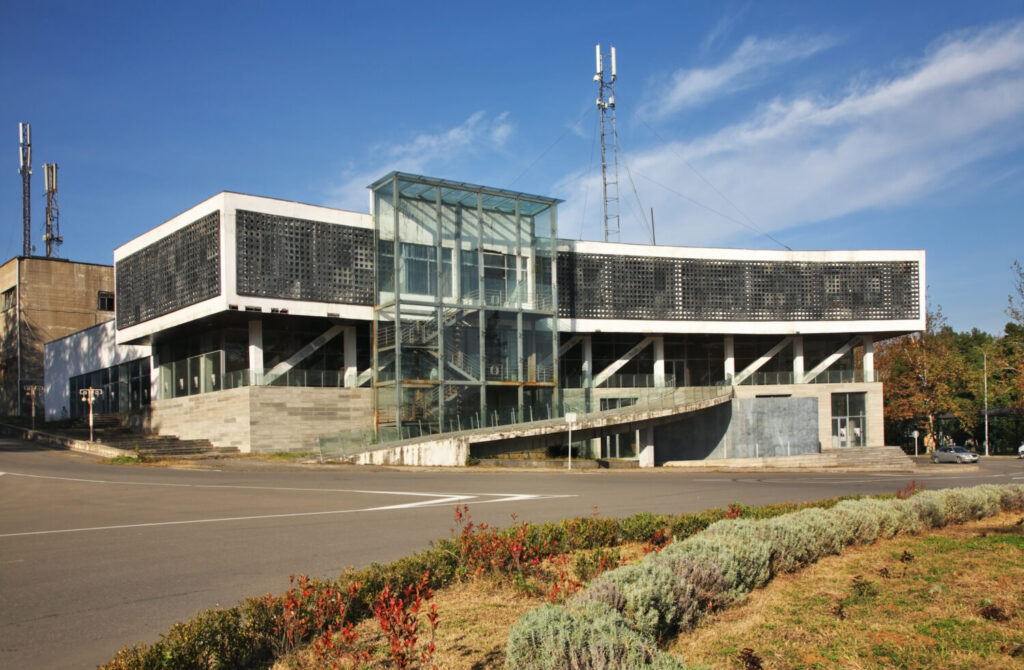
Practical Travel Tips for Visiting Tskaltubo’s Abandoned Sanatoriums
Visiting Tskaltubo is like stepping into a forgotten chapter of Soviet history. The town’s abandoned sanatoriums are hauntingly beautiful, but exploring them requires some planning.
While they may look solid from the outside, many are structurally unstable, and some are still partially inhabited. Knowing how to move around safely and respecting the locals are both essential for a smooth visit.
The Best Time of Year to Visit Tskaltubo
The best times to visit Tskaltubo are spring and autumn. The weather is mild, and with fewer visitors, it’s easier to appreciate the quiet, eerie beauty of the ruins.
In summer, the lush greenery surrounding the sanatoriums creates a surreal contrast with their faded facades. They are ideal for photography, but sometimes uncomfortably hot for exploring.
Winter can be atmospheric, but expect colder temperatures and occasional rain, which can make some areas slippery.
How to Get to Tskaltubo from Kutaisi or Batumi
Tskaltubo is just 15 minutes from Kutaisi by taxi or minibus, making it an easy day trip from the biggest city nearby. If you’re coming from Batumi, you can take a train or bus to Kutaisi and then continue onwards to Tskaltubo. As you know, if you have already read other blog posts about this trip, I chose to stay in Tskaltubo.
The sanatoriums are spread out, and, although they appear close on a map, some are uphill or hidden behind overgrown paths. Exploring entirely on foot is quite impractical.
I rented a car for my whole trip via DiscoverCars, and it made visiting the sanatoriums much easier. Guided tours are also available if you prefer not to drive or want the added benefit of a local’s knowledge.
If you’d rather explore with a knowledgeable guide, here are two excellent options:
- Kutaisi: Tskaltubo Abandoned Soviet‑Era Spas Tour on GetYourGuide: a 4‑hour small‑group tour, highly rated and perfect for history or urbex lovers
- Abandoned Sanatoriums of Tskaltubo Half Day Tour on Viator: informative, friendly, and very popular, with an expert local guide
Both experiences include transportation from Kutaisi, local insights, and guaranteed access to the best ruins. If you choose a guided tour, you don’t have to worry about grey areas or security concerns.

The Best Places to Stay in Tskaltubo to Explore the Sanatoriums
While many sanatoriums remain abandoned, some have been beautifully restored into hotels and wellness centres, offering a unique chance to stay in buildings that were once part of the Soviet spa network.
Tskaltubo Spa Resort, a former military sanatorium that has been partly renovated into a 4-star hotel, is a perfect example of how these historic structures are being revived. Today, it blends modern comforts with its original Soviet charm.
You can also stay in town to save more time to explore without rushing back to Kutaisi in the evening. Another great option is the Tskaltubo Epic Hotel & Spa, near the Prometheus Cave. I totally enjoyed the big swimming pool and the spa area after a day of exploring the surroundings.
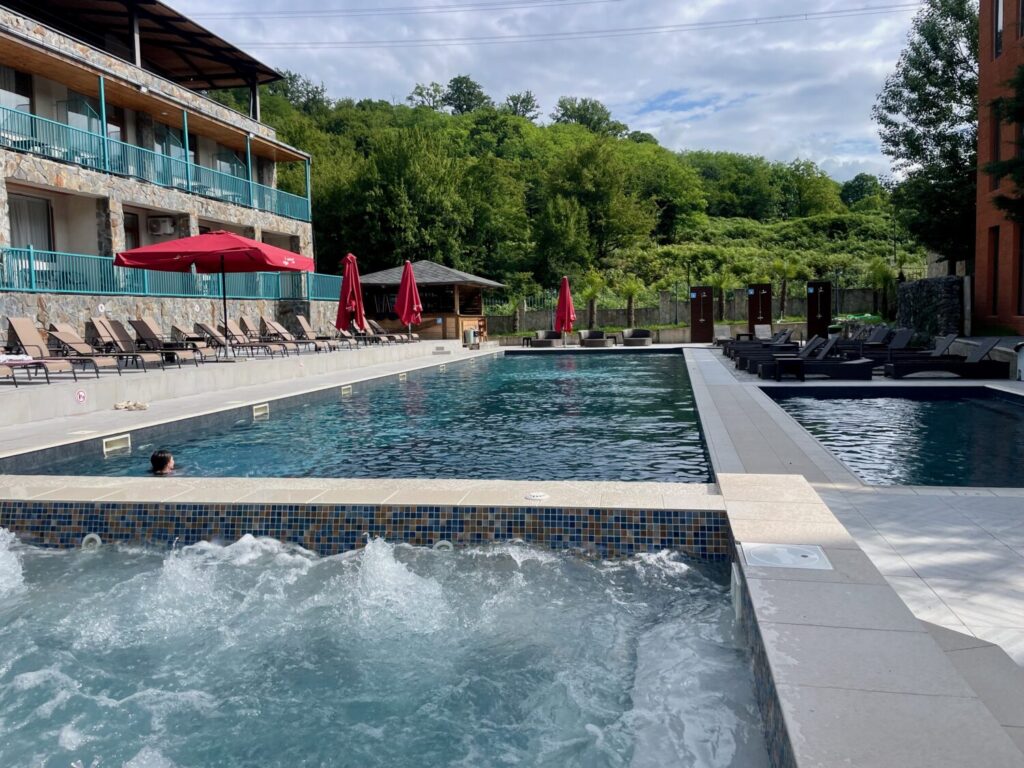
What to Combine with a Trip to Tskaltubo
You can easily combine a visit to Tskaltubo with other fascinating sites nearby. Prometheus Cave is just a few kilometres away from the city centre and offers an unforgettable underground experience with stunning rock formations.
Kutaisi, one of Georgia’s oldest cities, is close by and perfect for exploring its historic centre, colourful market, and the UNESCO-listed Gelati Monastery. If you love nature, there are nearby reserves and parks ideal for scenic hikes, picnics, and relaxing in unspoilt landscapes after your urban exploration adventure.
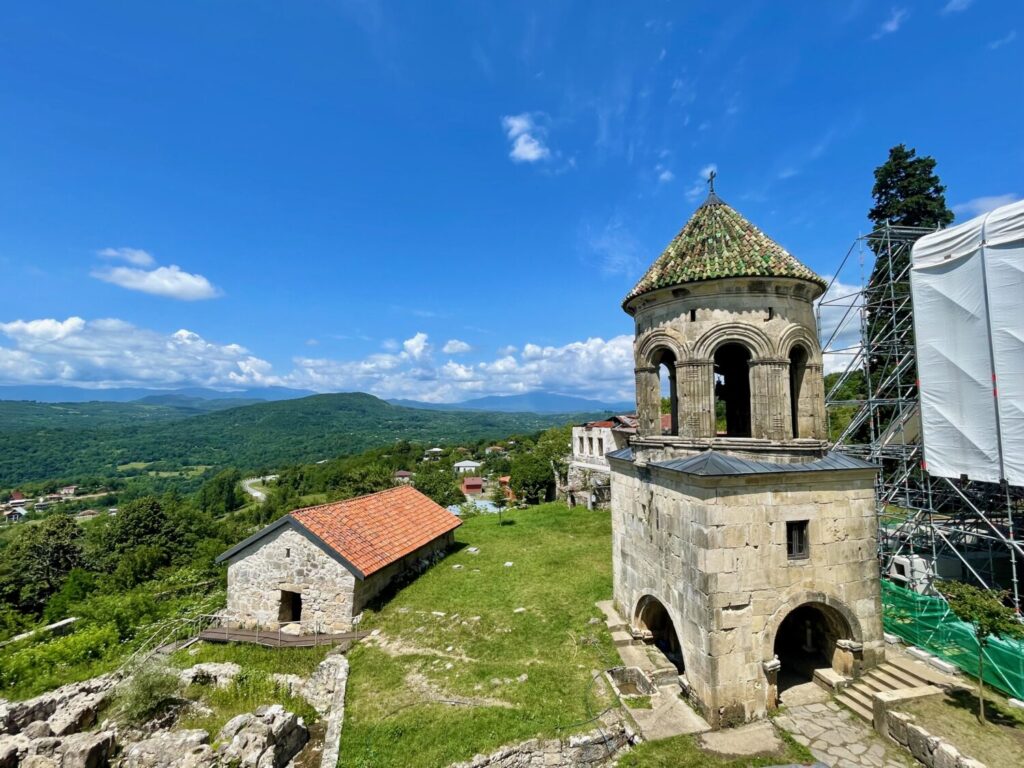
If you prefer visiting the surrounding attractions in a smooth and insightful experience, here are some highly rated surrounding tours you can easily book online:
- Private tour from Kutaisi: Martvili, Okatse, and Prometheus on GetYourGuide: a fascinating exclusive day trip combining the most beautiful natural wonders around Kutaisi.
- Martvili & Okatse Canyons & Cave Guided Tour on GetYourGuide: explore breathtaking canyons, suspension bridges, and waterfalls with a knowledgeable guide.
- Bagrati Cathedral, Gelati Monastery, and Motsameta Monastery from Kutaisi on Viator: perfect if you want to go deep into history, architecture, and religious traditions in a single day.
- Kutaisi Walking Tour on Viator: a popular tour with stops at all the top attractions, such as Bagrati Cathedral, Colchis Fountain, Kutaisi State Opera, and Ballet Theatre.
These tours are a fantastic way to enrich your visit to western Georgia, blending Tskaltubo’s eerie Soviet past with the region’s natural and cultural treasures.
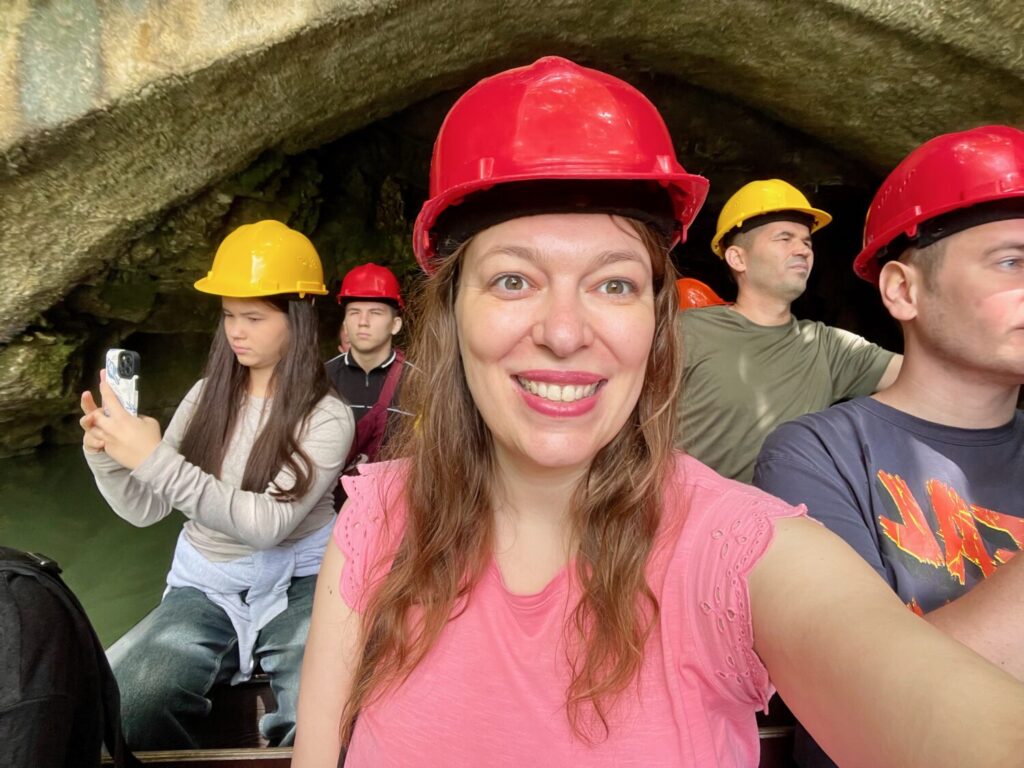
Why Tskaltubo Should Be on Your Georgia Itinerary
Tskaltubo is so much more than a collection of abandoned buildings. It’s a melancholic, frozen in time, travel experience into Soviet history, architecture, and culture. Wandering through its grand yet decaying sanatoriums is like stepping into another era. I personally found the experience super interesting. Exploring these ruins gave me a glimpse into a past I had only read about, and it was both haunting and fascinating at the same time. Feel free to share in the comments if you already visited Tskaltubo, or if you are just curious about forgotten places like this.
